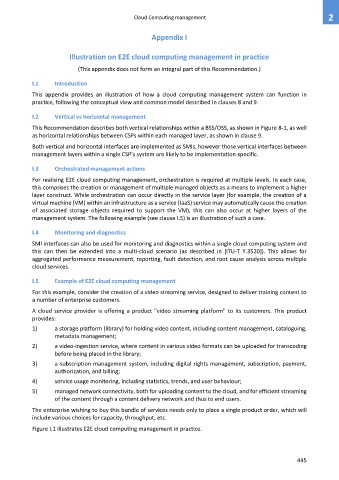Page 453 - Cloud computing: From paradigm to operation
P. 453
Cloud Computing management 2
Appendix I
Illustration on E2E cloud computing management in practice
(This appendix does not form an integral part of this Recommendation.)
I.1 Introduction
This appendix provides an illustration of how a cloud computing management system can function in
practice, following the conceptual view and common model described in clauses 8 and 9.
I.2 Vertical vs horizontal management
This Recommendation describes both vertical relationships within a BSS/OSS, as shown in Figure 8-1, as well
as horizontal relationships between CSPs within each managed layer, as shown in clause 9.
Both vertical and horizontal interfaces are implemented as SMIs, however those vertical interfaces between
management layers within a single CSP's system are likely to be implementation-specific.
I.3 Orchestrated management actions
For realising E2E cloud computing management, orchestration is required at multiple levels. In each case,
this comprises the creation or management of multiple managed objects as a means to implement a higher
layer construct. While orchestration can occur directly in the service layer (for example, the creation of a
virtual machine (VM) within an infrastructure as a service (IaaS) service may automatically cause the creation
of associated storage objects required to support the VM), this can also occur at higher layers of the
management system. The following example (see clause I.5) is an illustration of such a case.
I.4 Monitoring and diagnostics
SMI interfaces can also be used for monitoring and diagnostics within a single cloud computing system and
this can then be extended into a multi-cloud scenario (as described in [ITU-T Y.3520]). This allows for
aggregated performance measurement, reporting, fault detection, and root cause analysis across multiple
cloud services.
I.5 Example of E2E cloud computing management
For this example, consider the creation of a video streaming service, designed to deliver training content to
a number of enterprise customers.
A cloud service provider is offering a product "video streaming platform" to its customers. This product
provides:
1) a storage platform (library) for holding video content, including content management, cataloguing,
metadata management;
2) a video-ingestion service, where content in various video formats can be uploaded for transcoding
before being placed in the library;
3) a subscription management system, including digital rights management, subscription, payment,
authorization, and billing;
4) service usage monitoring, including statistics, trends, and user behaviour;
5) managed network connectivity, both for uploading content to the cloud, and for efficient streaming
of the content through a content delivery network and thus to end users.
The enterprise wishing to buy this bundle of services needs only to place a single product order, which will
include various choices for capacity, throughput, etc.
Figure I.1 illustrates E2E cloud computing management in practice.
445

